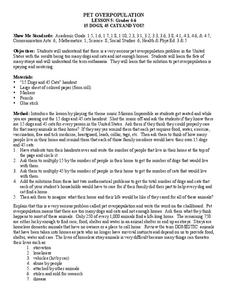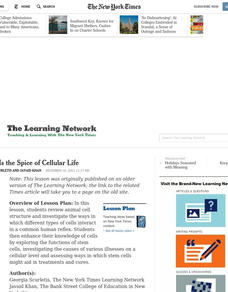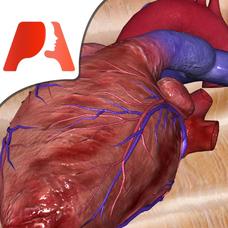Curated OER
4-H Companion Animal Project
In this 4-H animal science activity, students will complete several activities about companion animals. Students will learn about feline feelings, dog breeds and their different groups, rabbit vocabulary and ideas for service projects...
Curated OER
The Good and Bad Bacteria
Students are able to name one kind of harmful bacteria and why it hurts us and also name one kind of helpful bacteria and how we use it. They describe the process of growing bacterial cultures in a lab. Students create a reasonable...
Curated OER
Fabulous Felines
Students explore basic needs through discovering that pets and people need very similar things. They will play matching games, sing songs, read books, and discuss the needs of people and animals.
Curated OER
AP: Chapter 45: Chemical Regulation & Communication - Hormones and the Endocrine System
Infuse your AP biologists with the details of the endocrine system. This six-page worksheet queries learners thoroughly about gland structure and hormone function. Ms. Foglia, the author, has not left anything out of this resource,...
NASA
Earth, Can You Hear Me Now?
How long did you say? Class groups plot the distances between Earth and Mars and determine the trigonometric function that models the data. Using a calculator, they graph the function to determine when the distance and communication...
Curated OER
Behavior Adaptations
For this behavior worksheet, students review different types of behavioral adaptations including migration, hibernation, and communication. This worksheet has 10 matching and 10 true or false questions.
Curated OER
Baby Cell Facts of Life
Students examine the roles of an animal cell's parts, how each part relates to one another and then demonstrate their knowledge by writing a story about the animal cell structure.
Curated OER
What's Wild? What's Not?
Students complete activities to differentiate between wild and domestic animals. In this animal types lesson, students bring stuffed animals to class and pictures from magazines or newspaper. Students put their stuffed animals in a box...
Curated OER
Burs in Your Furs
Students explore the concept of animal welfare. In this wild animal habitats lesson, students discover the work of wild animals in sustaining their habitats as they participate in a classroom simulation. Students discuss how wildlife...
Curated OER
Pet Overpopulation
Learners identify the needs of animals. In this animal welfare lesson, students read the article "If This Cat Could Wish" and identify the needs of animals. Learners color in a coloring sheet of a cat.
Curated OER
Pet Overpopulation
Students explore the concept of pet overpopulation. In this animal welfare instructional activity, students complete and discuss handouts regarding the spaying and neutering of pets to reduce pet overpopulation.
Curated OER
All Ears for Adaptation
Students discuss different characteristics that enable animals to adapt to their environments. They work in pairs with one partner standing about one foot behind the other partner and cup their hands around their ears with palms forward....
Curated OER
Animal Behavior
In this animal behavior instructional activity, learners will review various types of animal behavior including those that are instinctual and those that are learned. This instructional activity has 10 true or false and 8 matching...
Curated OER
Are You an Animal Safety Sleuth?
Learners complete activities to investigate natural disasters and the impact on animals. In this natural disaster and animal safety lesson, students discuss the importance of safety procedures. Learners use a map of their school and...
Curated OER
Postcards From Noah's Ark
Students complete a research project on a selected animal as the culminating activity on a unit about animals. They write a descriptive postcard sent by the animal as a passenger on Noah's Ark, and with a partner create a PowerPoint...
Curated OER
How Do You Know A Panther Was Here?
Students research the signs that panthers leave. For this panther track lesson, students conduct Internet research into the signs that panthers leave such as tracks, scat, scrapes, and scratches. They make a three-dimensional poster...
Curated OER
Animal Coverings
Students compare and contrast the types of coverings found on animals. They identify a wide variety of animals in a museum room. They classify animals based on their coverings as well.
Curated OER
The Way We Were: Embryological Development and Disease
Young scholars use microscopes to study live fish embryos and animated diagrams of cell division on the Internet. They see that scientists rely on technology to enhance the gathering and manipulation of data. They create web pages on...
Curated OER
Variety Is the Spice of Cellular Life
Do you need to review animal cell structure? Investigate the ways in which different types of cells interact in a common human reflex. Your students can explore the functions of stem cells, consider various illnesses and assess stem...
Curated OER
Talking Duck
Students visit a local wetland or WWT centre and record their observations by writing or drawing on the downloadable pupil activity sheet.
Curated OER
Go Fish
Help learners discover methods to estimate animal population. They will participate in a simulation of catching and tagging fish in order to estimate the fish population. They scoop and count goldfish crackers, record data, and use...
Curated OER
Termite Trail Marking Behavior
Students examine termites and their trail-marking behaviors. They draw lines on paper with various ink pens and experiment to see which types of ink the termites follow--or which inks do and do not elicit trail marking behavior.
Pocket Anatomy
Pocket Heart
An all-encompassing, fully interactive, gorgeously animated model of the heart can be used to teach cardiac anatomy, physiology, and even a touch of epidemiology.
Lerner Publishing
Teaching Habitats
What makes up a habitat? Use this resource to engage first graders in the exploration of desert, wetland, forest, and ocean habitats. Youngsters classify plants and animals into the four distinct habitats through drawings and cutting and...

























